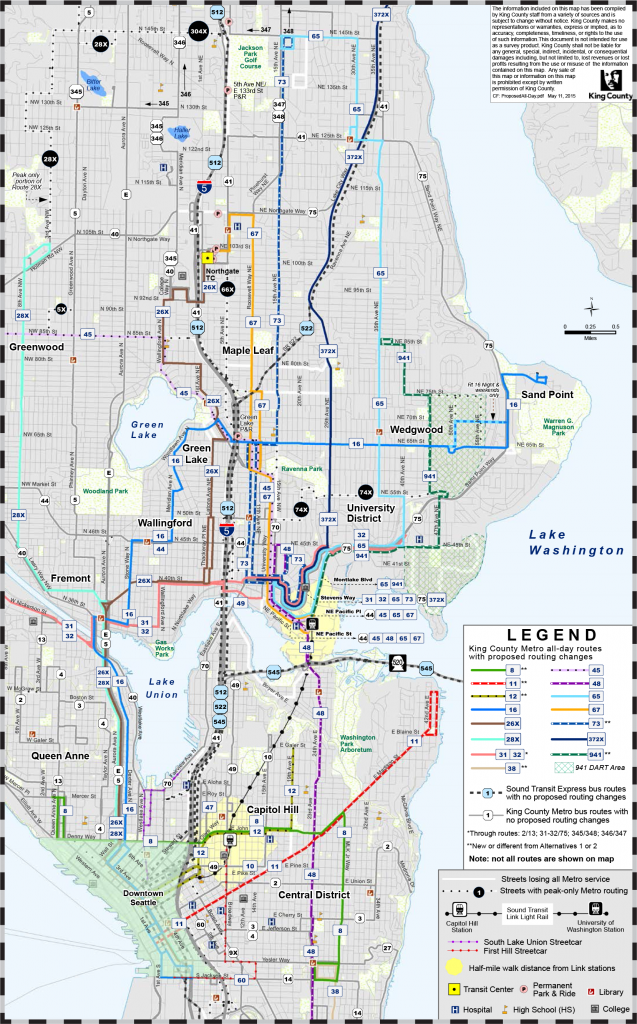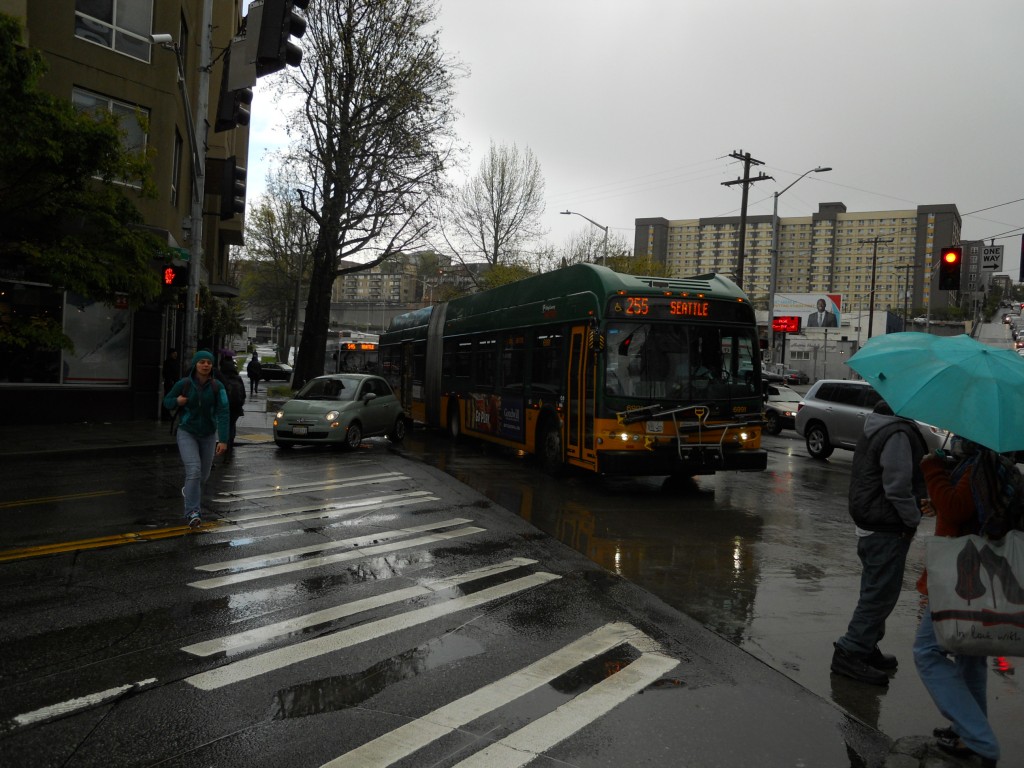
Today, King County Metro released a more refined “Alternative 3” for how bus service could be restructured around Seattle’s two new light stations, opening in early 2016. This proposal is a hybrid of two earlier options and incorporates a wide variety of public feedback. And, critically, this version includes Prop 1 service hours approved by Seattle voters in 2014. Throughout May, Metro and Sound Transit are conducting another round of public outreach to see where tweaks can be made, and then a final proposal will be sent to the King County Council this summer and implemented March 2016. Check the Metro website for more information on that.
Metro staff heard the most excitement for Alt 1 in northeast Seattle, where several routes are proposed for consolidation, realignment, and boosts in frequency. There was less consensus for either Alt 1 or 2 in the Capitol Hill area. Alt 3 is a compromise among competing interests but provides a much simpler network that will provide convenient connections to the new light rail stations.
Route deletions are much less dramatic under Alt 3 with only the 25, 30, 43, 68, 71, 72, and 242 being removed from the network.

Northeast Seattle
This is a summary of the major changes in Alternative 3 north of the Ship Canal.
- The 16 realignment from Alt 1 is kept as a long east-west connector serving Sand Point, Green Lake, Fremont, and Downtown with frequent service all day and week.
- The 48 is split into two routes that overlap on University Way (The Ave). The southern part, the 48, terminates on the UW campus; in a separate process, it is proposed for electrification (PDF). The northern part, the 45, still connects to Loyal Heights and terminates in a loop around the Montlake Triangle in front of the UW Link station.
- The 64X is a current peak-only route connecting the 35th Avenue corridor with Downtown and First Hill; in Alt 3, it skips Downtown and goes through South Lake Union instead.
- The 65 has increased peak and midday weekday service and is rerouted with a “live loop” at its southern terminus; it moves westbound on Stevens Way (on the UW campus) and eastbound on Pacific Street.
- The 67 is rerouted onto The Ave and also terminates at the UW Link station. It will have boosts in frequency all day and week.
- The 70 has no route changes but has boosts in weekend service. When both Alt 1 and 2 proposed terminating at the UW Link station the Sounding Board raised the point that it connects Eastlake residents with University District grocery stores.
- The 73 is retained along 15th Avenue, serves the Roosevelt/11th corridor, and terminates on the UW campus. It has 30 minute headways. Public feedback included a concern for long walks over hilly terrain in earlier proposals.
- The 372X is routed as a “UW to UW” service, connecting between the University District campus and UW Bothell. Currently it goes further to Woodinville. It will have frequency boosts all day and week.
- The 941 is a new dial-a-ride van service that preserves service between Wedgwood and Laurelhurst to the UW Link station. It has a fixed route running once per hour, but riders can call Metro two hours in advance to schedule a pick-up or drop-off in select areas abutting the route.
There will be extremely frequent service to the UW Link station from the University District and Roosevelt; with the 45, 48, and 67, a bus to the station will come by every three to five minutes during the morning and afternoon weekday peaks. These three routes would run down The Ave, which I still have reservations about due to 15th Avenue’s capacity. The routes would be rerouted 3 to 4 blocks away to the Roosevelt/11th corridor on Saturdays to detour around the University District Farmer’s Market.
However, having 15th Avenue lose bus service between 50th and 65th Streets may support the idea for a street reconfiguration that would see the addition of new protected bike lanes. Buses may also avoid delay from SDOT’s proposed reconfiguation of the Cowen Place intersection.
Capitol Hill
This is a summary of the major changes in Alternative 3 in central Seattle.
- The 8 is split like in Alt 1, but not around Broadway; the new southern part, the 38, overlaps with the 8 in the Central District. The only frequency change is a boost for the 8 to twelve minute headways during midday.
- The 11 is rerouted almost entirely along Madison Street with frequency boosts throughout the day and week. This is a prototype of Madison BRT that SDOT and Metro are planning now.
- The 12 is preserved with minor boosts in frequency. Under Alt 1 it was deleted, but there were public concerns about the hills in the area. With the 11 on Madison, the 12 is rerouted to the Pike/Pine corridor via John Street to fill a gap from the deleted 43.
- The 47 will be restored in June. It was deleted in a round of service cuts in September 2014.
Service levels on the Pike/Pine corridor are kept at their current levels.
The Eastside
Metro is no longer proposing any route changes for the Eastside. They did not receive an adequate amount or direction of public feedback from those communities. Similarly, Sound Transit has toned down their proposed routing changes for SR-520 express routes, but is making some notable tweaks.
- The 540 is rerouted to serve the Houghton Park and Ride along I-405 instead of southern Kirkland. It will be reduced to 30 minute headways, but when combined with Metro’s 277 the corridor will have combined 15-minute service between Houghton and the University District during peak.
- The 541 is a new peak-only route between Overlake Village Park and Ride to the University District.
- The 542, a peak-only route, will extend to Bear Creek Park and Ride and maximize the use of articulated buses.
- The 545, an all-day route, also currently terminates at Bear Creek Park and Ride.
The 540, 541, and 542 will all stop at the UW Link station. Alternatively, riders from any of those routes could transfer at an SR-520 freeway station to the 545, which will continue to serve Downtown Seattle.
This refreshed proposal is a much clearer and robust transit network than the earlier alternatives. This network quickly connects many residents with the two new Link stations while also preserving some alternate options for getting to Downtown, the region’s primary employment center and travel destination. More information and details are available via YouTube in the Talk with Ted Day series and on the U-Link Connections website. Metro is accepting feedback via surveys, emails, phone calls, and public events through May 31. The online survey can be found here.
Article Note: This article is a cross-post from The Northwest Urbanist.
Editor’s Note: The route 545 notes have been corrected. Turnbacks for the 545 were discussed in earlier meetings but were not in the final proposal. Additional a link the online survey for collecting comments has been added.
Scott Bonjukian has degrees in architecture and planning, and his many interests include neighborhood design, public space and streets, transit systems, pedestrian and bicycle planning, local politics, and natural resource protection. He cross-posts from The Northwest Urbanist and leads the Seattle Lid I-5 effort. He served on The Urbanist board from 2015 to 2018.



